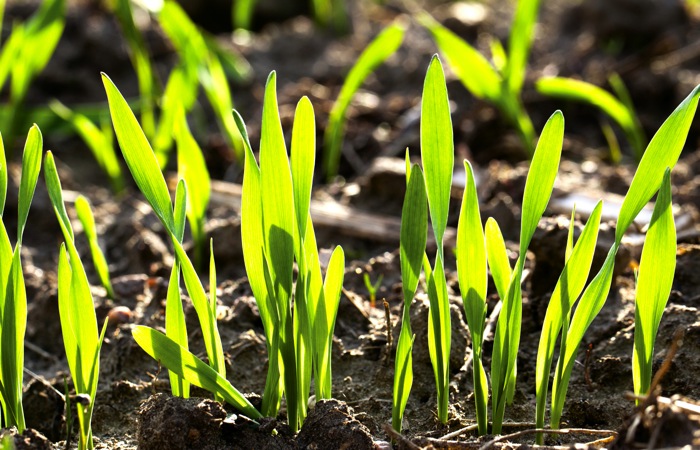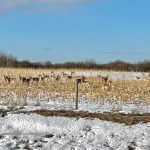Many farmers in Western Canada band their nitrogen (N) fertilizer before seeding or place all fertilizer in a side or mid-row band at the time of planting for their cereal and oilseed crops. Both are very sound practices. After seeding, most of the N fertilizer will slowly convert from ammonium nitrate (NH4+) to nitrate nitrogen (NO3-), the form of N that plants take up. Most of the N taken up by oilseeds and cereals is in the nitrate form. As long as nitrate losses from leaching and denitrification are minimal in spring and early summer, efficiency of N uptake should be in the range of 60 to 70 per cent, which is very good. With these conditions, there is probably little advantage to in-crop N application.
Read Also

Claas brings 1000 Series SP forage harvesters to Canada
In mid-August, Claas unveiled its new line of Jaguar forage harvesters at an event in Visalia, California, deep in the heart of that state’s dairy region.
But some agronomists suggest postponing application of a portion of N fertilizer until the crop is actively growing, when the crop is better able to utilize the nitrogen. Is “spoon feeding” a good approach?
Two key questions to consider in deciding if in-crop N application would benefit you are:
- What are your potential N losses after seeding? And,
- How can you efficiently apply in-crop N fertilizer?
Nitrate-N can be vulnerable to loss after heavy precipitation due to leaching, particularly in sandy soils. Very wet soil conditions can result in denitrification of N, particularly in medium and fine textured soils. Denitrification occurs in very wet, warm soils and is caused by soil bacteria striping oxygen from nitrate-N, converting it to gaseous nitrous oxide. Depending on soil and climate, significant N loss can occur in spring and early summer. But, if soil N losses are low between the time of fertilizing and beginning of July, the benefits of in-crop application will probably be low.
In-crop application
There are several ways to apply in-crop N, but none are ideal. Liquid 28-0-0 can be dribble banded or applied with spray jet nozzles. Urea (46-0-0) granular fertilizer can be broadcast. But remember, urea is subject to volatilization, so a urease inhibitor should be used to minimize volatilization (gaseous) losses when applied. Also remember that 50 per cent of N in 28-0-0 is in urea form and subject to volatilization. And, after application, rain must move the N fertilizer into soil. Once N fertilizer is moved into soil, it will take two to three weeks for the majority of the fertilizer to convert to nitrate-N for plant uptake. So, from the time of application to the time the fertilizer is available could be easily be three to four weeks. Therefore, for both in-crop broadcast 46-0-0 and in-crop application of 28-0-0, the very best efficiency of uptake would be 30 to 40 per cent, and would only occur if precipitation moved the fertilizer into the soil within a few days after application and the product was applied by late June. In a best case scenario, if 40 pounds of N per acre was applied with an uptake efficiency of 40 per cent, only 16 lbs. N/ac. would actually be taken up by the crop.
For foliar application of 28-0-0, the maximum application rate using spray nozzles is about 20 lbs. N/ac. to avoid leaf burn. Generally, less than five per cent of the applied N is taken up via the leaves in a best case scenario, which means less than one lb. of N/ac. of a 20 lbs. N/ac. application would be taken up the foliage, which is almost insignificant to increase crop yield. The N fertilizer would have to be washed from the leaves by rain and moved into the soil, then converted to nitrate for plant uptake. This method of application is not normally recommended, as the efficiency of uptake tends to be quite low.
Broadcast application of ammonium nitrate (34-0-0) is the best in-crop product with very little potential N loss. Half the N in the fertilizer is in the plant-available form of nitrate, which is immediately available to a crop after rain. Unfortunately, only a couple of companies import 34-0-0 in to Western Canada so availability is generally extremely limited. If you have access to it, 34-0-0 is an excellent N fertilizer for in-crop application.
If leaching or denitrification is not normally a problem, banding before seeding or preferably at seeding will result in the best efficiency of uptake for cereal and oilseed crops. In wetter regions, particularly in June, it may be beneficial to reduce N application in spring by 20 to 40 per cent and apply a split application about mid-June for availability in early July. Rates of 30 to 50 lbs. N/ac. will be necessary when application efficiency is 40 per cent or less.
In wetter regions with increased concerns of N losses, another option at planting is use a combination of urea and a slow release N fertilizer in a ratio such as 40:60 to reduce potential N losses. Studies by Alberta Agriculture with wheat, barley and canola with urea, ESN and a blend of urea/ESN have shown clear benefits using ESN when N losses are potentially higher.
















